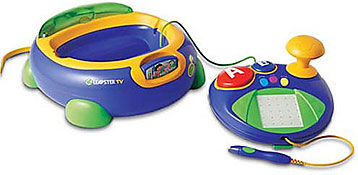Leapster TV
Feedsee Toys : Leapster TV : LeapsterTV educational game console from LeapFrog
 This new educational game console plugs into the family television and works with the entire Leapster software library. LeapsterTV provides each player with an individual learning path and teaches essential skills for pre-K to 4th grade. The fun-to-use learning games track each child's progress and include tutorials to help teach new concepts. It's also the only educational game console that uses a stylus and a touchpad to help develop important writing and fine motor skills. Ages 4 and up.
This new educational game console plugs into the family television and works with the entire Leapster software library. LeapsterTV provides each player with an individual learning path and teaches essential skills for pre-K to 4th grade. The fun-to-use learning games track each child's progress and include tutorials to help teach new concepts. It's also the only educational game console that uses a stylus and a touchpad to help develop important writing and fine motor skills. Ages 4 and up.
Evolution of Educational Software
Educational software has undergone significant transformation over the years, paralleling the rapid advancements in technology. From its rudimentary beginnings to the interactive and personalized platforms of today, here's a look at its progression:
- Early Beginnings: In the 1960s and 1970s, the initial educational software programs were created for mainframe computers. These were largely text-based, focusing on drill and practice exercises in subjects like math and language arts.
- Personal Computers Era: The 1980s saw the rise of personal computers, making educational software more accessible. Programs like "The Oregon Trail" and "Where in the World is Carmen Sandiego?" combined education with entertainment, pioneering the "edutainment" concept.
- Interactive Multimedia: The 1990s introduced multimedia elements such as video, audio, and animation into educational software. CD-ROMs became prevalent, offering interactive lessons, simulations, and encyclopedias that enriched the learning experience.
- Internet Integration: With the advent of the internet in the 2000s, online platforms, virtual classrooms, and educational websites emerged. This allowed for real-time collaboration, instant feedback, and access to a plethora of resources from around the world.
- Adaptive Learning: Modern educational software began to incorporate adaptive learning algorithms, tailoring content to individual student needs, ensuring a more personalized learning journey.
- Mobile Learning: The rise of smartphones and tablets led to the development of educational apps, catering to various age groups and subjects, and enabling learning on-the-go.
- Virtual and Augmented Reality: Recent advancements have seen the integration of VR and AR into educational software, offering immersive and experiential learning opportunities, from virtual labs to historical site explorations.
- AI and Big Data: Today, AI-driven platforms can analyze student data, predict learning outcomes, and offer tailored recommendations. Big data analytics helps in understanding learning patterns and refining educational methodologies.
As educational software continues to evolve, its primary objective remains clear: to enhance and enrich the learning experience, making it more engaging, interactive, and tailored to individual needs.